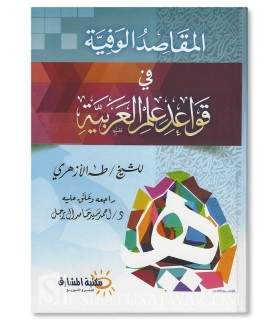

(In reply to someone saying: I shall close the windows.) 10. (In reply to someone saying: I shall be trustworthy). (In reply to someone saying: I shall visit your city.) 8. Al-Nahw al-wadih (The Clear Arabic Grammar), Primary Level, Part One, of 11Ħ LESSON 10: NASB (SUBJUNCTIVE CASE) OF THE FI L MUDARI 1. LESSON 9: THE JUMLAH ISMIYYAH (NOUN-BASED OR NOMINAL SENTENCE) RULE 12: Every sentence consisting of a subject (mubtada ) and its predicate (khabar) is called a jumlah ismiyyah (noun-based or nominal sentence). LESSON 8: THE JUMLAH FI LIYYAH (VERB-BASED OR VERBAL SENTENCE) RULE 11: Every sentence consisting of a verb (fi l) and its subject (fa il) is called a jumlah fi liyyah (verb-based or verbal sentence). RULE 10: The khabar (predicate) is an ism marfu (noun in the nominative case) that, along with the mubtada, forms a complete sentence (jumlah mufidah). RULE 9: The mubtada (subject of a sentence) is an ism marfu (noun in the nominative case) at the beginning of the sentence. Al-Nahw al-wadih (The Clear Arabic Grammar), Primary Level, Part One, of 11ĥ LESSON 7: THE MUBTADA AND KHABAR (SUBJECT AND PREDICATE OF A SENTENCE) 1. The maf ul bihi ends in the mansub (accusative) case. The fa il ends in the marfu (nominative) case. The maf ul bihi is the one to whom/which the action is done. The fa il is the one who/which does the action (fi l). The fa il and maf ul bihi are both nouns (ism). LESSON 6: COMPARISON OF THE FA IL AND MAF UL BIHI 1. RULE 8: The maf ul bihi (object of a verb) is an ism mansub (noun in the accusative case) to which the action of the fa il (subject of the verb) applies. LESSON 5: THE MAF UL BIHI (OBJECT OF A VERB) 1. RULE 7: The fa il (subject of a verb) is an ism marfu (noun in the nominative case) preceded by a fi l (verb), and signifies whoever did the action. Al-Nahw al-wadih (The Clear Arabic Grammar), Primary Level, Part One, of 11Ĥ LESSON 4: THE FA IL (SUBJECT OF A VERB) 1.

RULE 6: The fi l amr (imperative tense) is every verb by which the occurrence of something in the future is requested (or commanded). It must begin with one of the letters of the mudari : hamzah, nun, ya or ta. 3.2 THE FI L MUDARI (PRESENT TENSE) RULE 5: The fi l mudari (present tense) is every verb that signifies the occurrence of an action in the present or future. RULE 4: The fi l madi (past tense) is every verb that signifies the occurrence of an action in the past. Al-Nahw al-wadih (The Clear Arabic Grammar), Primary Level, Part One, of 11ģ LESSON 3: CLASSIFICATION OF THE VERB WITH REGARD TO ITS TIME- PERIOD 3.1 THE FI L MADI (PAST TENSE) 1. c) The harf is every word whose meaning is not completely clear without other (accompanying) words. b) The fi l is every word that signifies the occurrence of an action at a particular time. a) The ism is every word by which a person, animal, plant, inanimate object or anything else is named. Do you like travelling? LESSON 2: PARTS OF THE SENTENCE RULE 3: Words are of three types: ism (noun/adjective), fi l (verb) and harf (particle). RULE 2: The complete sentence is composed of two or more words every word is counted as part of it (the sentence). RULE 1: The composition that gives a complete meaning is called a jumlah mufidah (complete sentence) it is also called kalam (speech). AL-NAHW AL-WADIH (THE CLEAR ARABIC GRAMMAR) by Ali al-jarim & Mustafa Amin Translation of the Examples and Grammatical Rules by Usama Hasan for the Arabic grammar course at Al-Tawhid College, London ( Al-Nahw al-wadih (The Clear Arabic Grammar), Primary Level, Part One, of 11Ģ PRIMARY LEVEL PART ONE LESSON 1: AL-JUMLAH AL-MUFIDAH (THE COMPLETE SENTENCE) 1.

1 With the Name of Allah, Most Merciful, Ever Merciful.


 0 kommentar(er)
0 kommentar(er)
